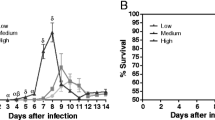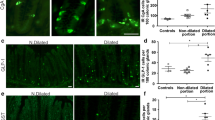Abstract
Infection with Trypanosoma cruzi causes megasyndromes of the gastrointestinal (GI) tract in humans and animals. In the present study, we employed magnetic resonance imaging to non-invasively monitor the effect of selenium supplementation on alterations in the GI tract of T. cruzi-infected mice. CD1 mice infected with T. cruzi (Brazil strain) exhibited dilatation of the intestines similar to that we recently reported in infected C57Bl/6 mice. The average intestine lumen diameter increased by 65% and the increase was reduced to 29% in mice supplemented with 2 ppm selenium in the drinking water. When supplemented with 3 ppm selenium in chow the lumen diameter was also significantly reduced although the difference between the infected and infected supplemented mice was smaller. Intestinal motility in infected mice fed with selenium-enriched chow was increased compared with infected mice fed with normal unsupplemented chow and was not significantly different from intestinal motility in uninfected mice. We suggest that Se may be used to modulate the inflammatory, immunological, and/or antioxidant responses involved in intestinal disturbances caused by T. cruzi infection.




Similar content being viewed by others
References
Boczko J, Tar M, Melman A, Jelicks LA, Wittner M, Factor SM, Zhao D, Hafron J, Weiss LM, Tanowitz HB, Christ GJ (2005) Trypanosoma cruzi infection induced changes in the innervation, structure and function of the murine bladder. J Urol 173:1784–1788
Broome CS, McArdle F, Kyle JA, Andrews F, Lowe NM, Hart CA, Arthur JR, Jackson MJ (2004) An increase in selenium intake improves immune function and poliovirus handling in adults with marginal selenium status. Am J Clin Nutr 80:154–162
Chu F, Esworthy R, Doroshow J (2004) Role of Se-dependent glutathione peroxidases in gastrointestinal inflammation and cancer. Free Radic Biol Med 36:1481–1495
da Silveira AB, Lemos EM, Adad SJ, Correa-Oliveira R, Furness JB, D'Avila Reis D (2007) Megacolon in Chagas disease: a study of inflammatory cells, enteric nerves, and glial cells. Hum Pathol 38:1256–1264
Davis CD, Brooks L, Calisi C, Bennett BJ, McElroy DM (1998) Beneficial effect of selenium supplementation during murine infection with Trypanosoma cruzi. J Parasitol 84:1274–1277
de Oliveira GM, de Melo MM, da Silva BW, Santana R, Araujo-Jorge TC, de Souza AP (2008) Applicability of the use of charcoal for the evaluation of intestinal motility in a murine model of Trypanosoma cruzi infection. Parasitol Res 102:747–750
De Rossell R, Rodriguez A, De Jesus R, Calcagno M, De Segnini Z, Diaz S (2000) Tripomastigotes de sangre y de cultivo celular de Trypanosoma cruzi Y.: II.-Patología de la enfermedad de Chagas en ratones Balb/c. Parasitol Día 24:79–87
de Souza AP, Melo de Oliveira G, Neve J, Vanderpas J, Pirmez C, de Castro SL, Araujo-Jorge TC, Rivera MT (2002) Trypanosoma cruzi: host selenium deficiency leads to higher mortality but similar parasitemia in mice. Exp Parasitol 101:193–199
de Souza AP, de Oliveira GM, Vanderpas J, de Castro SL, Rivera MT, Araujo-Jorge TC (2003) Selenium supplementation at low doses contributes to the decrease in heart damage in experimental Trypanosoma cruzi infection. Parasitol Res 91:51–54
Esworthy RS, Yang L, Frankel PH, Chu FF (2005) Epithelium-specific glutathione peroxidase, Gpx2, is involved in the prevention of intestinal inflammation in selenium-deficient mice. J Nutr 135:740–745
Gomez RM, Solana ME, Levander OA (2002) Host selenium deficiency increases the severity of chronic inflammatory myopathy in Trypanosoma cruzi-inoculated mice. J Parasitol 88:541–547
Hagger R, Finlayson C, Kahn F, De Oliveira R, Chimelli L, Kumar D (2000) A deficiency of interstitial cells of Cajal in Chagasic megacolon. J Auton Nerv Syst 80:108–111
Kirchhoff LV (1996) American trypanosomiasis (Chagas' disease). Gastroenterol Clin North Am 25:517–533
Kiremidjian-Schumacher L, Roy M (2001) Effect of selenium on the immunocompetence of patients with head and neck cancer and on adoptive immunotherapy of early and established lesions. Biofactors 14:161–168
Madrid AM, Defilippi C (2006) Disturbances of small intestinal motility in patients with chronic constipation. Rev Med Chil 134:181–186
Madrid AM, Quera R, Defilippi C, Gil LC, Sapunar J, Henriquez A (2004) Gastrointestinal motility disturbances in Chagas disease. Rev Med Chil 132:939–946
Maifrino LB, Liberti EA, de Souza RR (1999) Vasoactive-intestinal-peptide- and substance-P-immunoreactive nerve fibres in the myenteric plexus of mouse colon during the chronic phase of Trypanosoma cruzi infection. Ann Trop Med Parasitol 93:49–56
Maifrino LB, Amaral SO, Watanabe I, Liberti EA, De Souza RR (2005) Trypanosoma cruzi: preliminary investigation of NADH-positive and somatostatin-immunoreactive neurons in the myenteric plexus of the mouse colon during the infection. Exp Parasitol 111:224–229
Marona HR, Lucchesi MB (2004) Protocol to refine intestinal motility test in mice. Lab Anim 38:257–260
Matsuda N, Dantas R (2008) Mecanismos intracelulares dos mediadores inibitórios não adrenérgicos e não colinérgicos no trato gastrointestinal. (Intracellular mechanisms of the inhibitory non-adrenergic non-cholinergic mediators in the gastrointestinal tract). Revista Brasileira de Biociências 6:315–320
Mishra V, Baines M, Perry SE, McLaughlin PJ, Carson J, Wenstone R, Shenkin A (2007) Effect of selenium supplementation on biochemical markers and outcome in critically ill patients. Clin Nutr 26:41–50
Mori T, Yoon HS, Iizuka FH, Myung JM, Sato HR, Silva MF, Okumura M (1995) Intestinal transit and opaque enema study in chagasic mice. Rev Hosp Clin Fac Med Sao Paulo 50:63–66
Ny L, Li H, Mukherjee S, Persson K, Holmqvist B, Zhao D, Shtutin V, Huang H, Weiss LM, Machado FS, Factor SM, Chan J, Tanowitz HB, Jelicks LA (2008) A magnetic resonance imaging study of intestinal dilation in Trypanosoma cruzi-infected mice deficient in nitric oxide synthase. Am J Trop Med Hyg 79:760–767
Oliveira EC, Fujisawa MM, Hallal Longo DE, Farias AS, Contin Moraes J, Guariento ME, de Almeida EA, Saad MJ, Langone F, Toyama MH, Andreollo NA, Santos LM (2009) Neuropathy of gastrointestinal Chagas' disease: immune response to myelin antigens. Neuroimmunomodulation 16:54–62
Postan M, Cheever AW, Dvorak JA, McDaniel JP (1986) A histopathological analysis of the course of myocarditis in C3H/He mice infected with Trypanosoma cruzi clone Sylvio-X10/4. Trans R Soc Trop Med Hyg 80:50–55
Postan M, Bailey JJ, Dvorak JA, McDaniel JP, Pottala EW (1987) Studies of Trypanosoma cruzi clones in inbred mice. III. Histopathological and electrocardiographical responses to chronic infection. Am J Trop Med Hyg 37:541–549
Rayman MP (2000) The importance of selenium to human health. Lancet 356(9225):233–241
Rivera MT, de Souza AP, Moreno AH, Xavier SS, Gomes JA, Rocha MO, Correa-Oliveira R, Neve J, Vanderpas J, Araujo-Jorge TC (2002) Progressive Chagas' cardiomyopathy is associated with low selenium levels. Am J Trop Med Hyg 66:706–712
Scremin LH, Corbett CE, Laurenti MD, Nunes EV, Gama-Rodrigues JJ, Okumura M (1999) Megabladder in experimental Chagas disease: pathological features of the bladder wall. Rev Hosp Clin Fac Med Sao Paulo 54:43–46
Silva JS, Machado FS, Martins GA (2003) The role of nitric oxide in the pathogenesis of Chagas disease. Front Biosci 8:s314–325
Tanowitz HB, Kirchhoff L, Simon D, Morris SA, Weiss LM, Wittner M (1992) Chagas' disease. Clin Microbiol Rev 5:400–419
Tanowitz HB, Machado FS, Jelicks LA, Shirani J, de Carvalho AC, Spray DC, Factor SM, Kirchhoff LV, Weiss LM (2009) Perspectives on Trypanosoma cruzi-induced heart disease (Chagas disease). Prog Cardiovasc Dis 51:524–539
Acknowledgment
This work was supported in part by grants from the Unites States National Institute of Health grants CA123334 and AI062730 (LAJ) and AI076248 (HBT), Conselho Nacional de Desenvolvimento Científico e Tecnológico (CNPq), Coordenação de Aperfeiçoamento de Pessoal de Ensino Superior (CAPES), FIOCRUZ, and FAPERJ. All animal studies were performed in accordance with the guidelines established by the Institutional Animal Care and Use Committee of the Albert Einstein College of Medicine.
Author information
Authors and Affiliations
Corresponding author
Rights and permissions
About this article
Cite this article
de Souza, A.P., Sieberg, R., Li, H. et al. The role of selenium in intestinal motility and morphology in a murine model of Typanosoma cruzi infection. Parasitol Res 106, 1293–1298 (2010). https://doi.org/10.1007/s00436-010-1794-1
Received:
Accepted:
Published:
Issue Date:
DOI: https://doi.org/10.1007/s00436-010-1794-1




